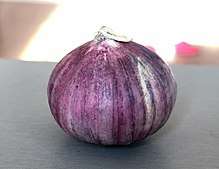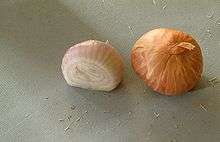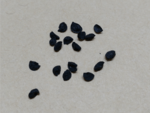Shallot
The shallot is a type of onion, specifically a botanical variety of the species Allium cepa.[1]
| Shallot | |
|---|---|
 A whole shallot | |
| Species | Allium cepa var. aggregatum |
| Cultivar group | Aggregatum Group |
The shallot was formerly classified as a separate species, A. ascalonicum, a name now considered a synonym of the currently accepted name.[2]
Its close relatives include the garlic, leek, chive,[3] and Chinese onion.[4]
Names

Shallots probably originated in Central or Southwest Asia, travelling from there to India and the eastern Mediterranean. The name "shallot" comes from Ashkelon, an ancient Canaanite city,[5] where people in classical Greek times believed shallots originated.[6]
The name shallot is also used for the Persian shallot (A. stipitatum), from the Zagros Mountains in Iran and Iraq. The term shallot is further used for the French red shallot (Allium cepa var. aggregatum, or the A. cepa Aggregatum Group) and the French gray shallot or griselle (Allium oschaninii), a species referred to as "true shallot";[6] it grows wild from Central to Southwest Asia. The name shallot is also used for a scallion in New South Wales, Australia[7] and among English-speaking people in Quebec while the term French shallot refers to the plant referred to on this page.[8] Anglophone Quebecers and British English speakers stress the second syllable of shallot, as "shall-OH" and "shall-OT" respectively (Australians and New Zealanders also say "shall-OT"), while other varieties of English pronounce it as "SHALL-ət".
The term eschalot, derived from the French word échalote, can also be used to refer to the shallot.[9]
Description and cultivation


Like garlic, shallots are formed in clusters of offsets with a head composed of multiple cloves. The skin colour of shallots can vary from golden brown to gray to rose red, and their off-white flesh is usually tinged with green or magenta.
Shallots are extensively cultivated for culinary uses, propagated by offsets. In some regions ("long-season areas"), the offsets are usually planted in autumn (September or October in the Northern Hemisphere).[10] In some other regions, the suggested planting time for the principal crop is early spring (typically in February or the beginning of March in the Northern Hemisphere).[11]
In planting, the tops of the bulbs should be kept a little above ground, and the soil surrounding the bulbs is often drawn away when the roots have taken hold. They come to maturity in summer, although fresh shallots can now be found year-round in supermarkets. Shallots should not be planted on ground recently manured. Shallots suffer damage from leek moth larvae, which mine into the leaves or bulbs of the plant.[12]
Culinary uses
| Nutritional value per 100 g (3.5 oz) | |
|---|---|
| Energy | 301 kJ (72 kcal) |
16.8 g | |
| Sugars | 7.87 g |
| Dietary fiber | 3.2 g |
0.1 g | |
2.5 g | |
| Vitamins | Quantity %DV† |
| Thiamine (B1) | 5% 0.06 mg |
| Riboflavin (B2) | 2% 0.02 mg |
| Niacin (B3) | 1% 0.2 mg |
| Pantothenic acid (B5) | 6% 0.29 mg |
| Vitamin B6 | 27% 0.345 mg |
| Folate (B9) | 9% 34 μg |
| Vitamin C | 10% 8 mg |
| Vitamin E | 0% 0.04 mg |
| Vitamin K | 1% 0.8 μg |
| Minerals | Quantity %DV† |
| Calcium | 4% 37 mg |
| Iron | 9% 1.2 mg |
| Magnesium | 6% 21 mg |
| Manganese | 14% 0.292 mg |
| Phosphorus | 9% 60 mg |
| Potassium | 7% 334 mg |
| Zinc | 4% 0.4 mg |
| |
| †Percentages are roughly approximated using US recommendations for adults. Source: USDA Nutrient Database | |
Shallots are used in cooking. They may be pickled. Finely-sliced deep-fried shallots are used as a condiment in Asian cuisine, often served with porridge. As a species of Allium, shallots taste somewhat like a common onion, but have a milder flavor.[13] Like onions, when sliced, raw shallots release substances that irritate the human eye, resulting in production of tears.
Fresh shallots can be stored in cool, dry area (0 to 4 °C, 32 to 40 °F, 60 to 70% RH) for six months or longer.[14] Chopped, dried shallots are available.[15]
Europe
In Europe, the Pikant, Atlas, and Ed's Red types of shallots are the most common. In parts of southern France, the grey type is grown widely.[6]
Asia
Shallots are the traditional choice for many dishes in Sri Lankan cuisine, including pol sambola, lunu miris and many meat, fish and vegetable dishes.
In most Indian cuisines, the distinction between onions and shallots is weak; larger varieties of shallot are sometimes confused with small red onions and used interchangeably. Indeed, most parts of India use the regional name for onion interchangeably with shallot (Maharashtra, for instance, where both are called kanda). The southern regions of India distinguish shallots from onions in recipes more often, especially the much loved tiny varieties (about the width of a finger); these are widely used in curries and different types of sambar, a lentil-based dish. Shallots pickled in red vinegar are common in many Indian restaurants, served along with sauces and papad on the condiments tray. Indians also use it as a home remedy for sore throats, mixed with jaggery or sugar. In Nepal, shallots are used as one of the ingredients for making momo. In Kashmir shallots are widely used in preparation of Wazwan Kashmiri cuisine, as they add distinct flavor and prevent curry from becoming black, which is common with onions.
In Iran shallots are used in various ways, the most common being grated shallot mixed into dense yogurt, a combination served in almost every restaurant when one orders grills or kebabs. Shallots are also used to make different types of torshi (ترشی), a sour Iranian side dish consisting of a variety of vegetables under vinegar, eaten with main dishes in small quantities. Shallot is also pickled—called shour (شور) in Persian—along with other vegetables to be served as torshi.
In Southeast Asian cuisines, such as those of Indonesia, Vietnam, Thailand, Cambodia, Malaysia, Philippines, Singapore and Brunei, both shallots and garlic are often used as elementary spices. Raw shallots can also accompany cucumbers when pickled in mild vinegar solution. They are also often chopped finely, then fried until golden brown, resulting in tiny crispy shallot chips called bawang goreng (fried shallots) in Indonesian, which can be bought ready-made from groceries and supermarkets. Shallots enhance the flavor of many Southeast Asian dishes, such as fried rice variants. Crispy shallot chips are also used in southern Chinese cuisine. In Indonesia, shallots are sometimes made into pickles that are added to several traditional foods; the pickles' sourness is thought to increase the appetite.
The tubular green leaves of the plant can also be eaten and are very similar to the leaves of spring onions and chives.
Gallery
- Shallots on sale in India
 A person chopping shallots for making satay
A person chopping shallots for making satay- Sliced shallots for bawang goreng in Indonesia.
- Bawang goreng crispy deep fried shallot is a popular garnishing in Indonesia
See also
References
- Fritsch, R. M.; N. Friesen (2002). "Chapter 1: Evolution, Domestication, and Taxonomy". In H. D. Rabinowitch and L. Currah (ed.). Allium Crop Science: Recent Advances. Wallingford, UK: CABI Publishing. p. 21. ISBN 0-85199-510-1.
- "Allium ascalonicum". Germplasm Resources Information Network (GRIN). Agricultural Research Service (ARS), United States Department of Agriculture (USDA). Retrieved 2010-08-20.
- Block, E. (2010). Garlic and Other Alliums: The Lore and the Science. Royal Society of Chemistry. ISBN 0-85404-190-7.
- "AllergyNet — Allergy Advisor Find". Allallergy.net. Archived from the original on June 15, 2010. Retrieved April 14, 2010.
- "shallot". New Oxford American Dictionary (Second ed.). Oxford University Press. 2005. ISBN 978-0-19-517077-1.
- Green, Aliza (2004), Field Guide to Produce: How to Identify, Select, and Prepare Virtually Every Fruit and Vegetable at the Market, Quirk Books, p. 256, ISBN 978-1-931686-80-8
- "Spring onions v shallots". Retrieved May 14, 2019.
- "Montreal public market site". Montreal public markets. Retrieved August 28, 2014.
- "Dictionary: eschalot". Merriam-Webster, Incorporated. Retrieved December 4, 2013.
- Hunt, Marjorie B. and Bortz, Brenda (1986), High-Yield Gardening, Pennsylvania: Rodale Press, ISBN 0-87857-599-5
- Seabrook, Peter (1976), Complete Vegetable Gardener, London: Cassell, ISBN 978-0-304-29738-2
- Landry, Jean-François. "Taxonomic review of the leek moth genus Acrolepiopsis (Lepidoptera: Acrolepiidae) in North America". The Canadian Entomologist. 139 (03): 319–353. doi:10.4039/n06-098.
- "Kitchen Dictionary: shallot". Scripps Networks. Retrieved December 4, 2013.
- "Onions, Garlic, and Shallots". Virginia Cooperative Extension. May 1, 2009. Archived from the original on September 1, 1999. Retrieved March 13, 2013.
- "Shallots, Freeze Dried". McCormick & Co. Inc. 2011. Retrieved March 13, 2013.
External links



.jpg)